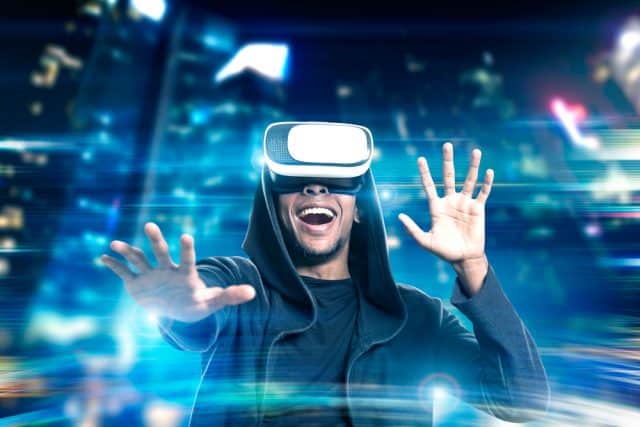Apple's rumored VR headset will be huge for the enterprise: Here's what IT needs to be thinking about now

After many years of speculation, Apple’s entrance into the VR/AR market is finally imminent. CEO Tim Cook hinted in an interview last month that he is "incredibly excited about AR" and to "stay tuned" to see what Apple has to offer. The Board has allegedly tested a headset out. The latest rumors suggest that Apple will unveil something by January 2023.
Whenever it happens, Apple releasing some sort of VR/AR device will be an absolute game changer for the industry. Apple moves markets. Its technology is always excellent. It knows how to drive mass appeal. Apple’s headset will, without a doubt, help push XR to widespread adoption, and maybe not in ways you’d expect. When people think of Apple products, their mind typically goes to consumer technology -- but it’s actually the enterprise that will likely come first in reaping the benefits of this new headset.
Here’s why. VR in general is on the cusp of widespread adoption in the enterprise. Many companies are starting to leverage VR/AR for things like employee training, patient care and sales enablement. Accenture, for example, recently announced that it deployed 60,000+ headsets to new employees and clients for onboarding. At the same time, Apple has been making more moves into the enterprise in recent years, from acquiring an MDM product to releasing Business Essentials. Businesses tend to trust Apple, which has positioned itself as a privacy-centric company with incredible (though expensive) hardware, especially compared to Meta, which is right now the leader in the space with Oculus.
So, anticipating that this new device from Apple will lead to a surge in enterprise usage, what should business and IT leaders be doing now to lay the foundation for a successful, scalable VR program? Regardless of the device manufacturer, there are four critical things to consider when scaling any VR program:
Content. Large scale deployments generally require organizations to source content from outside of consumer stores. While that notion might change once Apple joins the club, too often we hear about companies loving a certain piece of content from the Oculus store, for example, and wanting to put it on 200 devices across an organization. That just doesn’t work. At least for now, licensing content from stores at scale is really challenging and virtually impossible -- but there are several workarounds to consider. One option is custom content built in-house or through ISVs like Immerse or Pixo. There are also authoring tools, like CenarioVR, 3DVista or VRDirect, that help organizations easily develop interactive applications without the level of resources required for custom content. Great off-the-shelf collaboration and design tools, educational modules, and other meeting and VR tools exist as well, and while not custom, they can still bring a lot of great value.
Hardware. Organizations need to select hardware that supports their deployments at scale -- that doesn’t necessarily mean just the headsets, but what storage and cleaning will be required as well. If there is going to be shared usage of devices, figuring out how to store those devices is a big part of the logistics behind a large-scale deployment.
Teams. Using XR at scale requires a dedicated team that is ready to take on the challenge. VR is a new concept for most organizations and that means it will introduce challenges that no one in the organization has faced before. End-users (the ones actually putting the headsets on their heads), the implementers (the ones designing the XR programs, managing the deployments and measuring the success) and IT all play an important role in ensuring the success of a VR program. All too often, we see companies bringing in IT too late and blaming them for hurdles as programs expand - but successful large-scale deployments require IT to be integrated from the start.
Device Management. Once tens, hundreds or thousands of headsets are deployed, it can be incredibly hard to manage the devices, update modules, troubleshoot, etc. Imagine IT not being able to update software or remotely troubleshoot for a work laptop? That’s the reality for VR deployments if the organization is not thinking about VR/AR device management solutions. The good news is that software exists that allows organizations to remotely manage their devices, understand the health of their fleet, etc. -- all of the device management features they have grown to expect but aren’t necessarily available through the traditional MDM providers.
Many organizations have already started to realize the benefits of VR in the workplace, and this looming device from Apple will only push the path to mass adoption forward. However, whether organizations deploy fleets of Apple headsets, Oculus, Pico, Vive, or even a combination of them all, they will undoubtedly face challenges while shifting from early-stage adoption to cross-company solutions - and it’s critical to start planning now so that VR programs don’t die on the vine before they really take off across the enterprise.
Image credit: ImageFlow / Shutterstock

Luke Wilson is the founder and CEO of ManageXR, an enterprise device management platform for VR and AR devices that solves the challenges of working with XR at scale. Luke has worked in XR since 2015. In 2018, he founded Mighty Immersion with the intention of using immersive technologies to improve patient care. While working to deploy thousands of headsets to over 200 children’s hospitals across the U.S., Luke realized there was a fundamental scale boundary in XR deployment. How do we remotely sync, update, and control thousands of devices and streamline the end-user experience? This problem led Luke to build ManageXR, which officially launched in 2021.